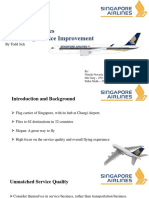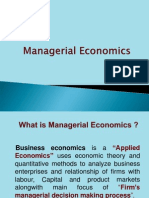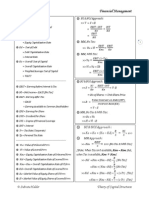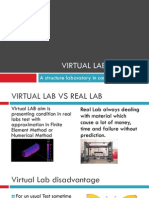Applications and Solutions of Linear Programming Session 1
Applications and Solutions of Linear Programming Session 1
Uploaded by
Simran KaurCopyright:
Available Formats
Applications and Solutions of Linear Programming Session 1
Applications and Solutions of Linear Programming Session 1
Uploaded by
Simran KaurOriginal Title
Copyright
Available Formats
Share this document
Did you find this document useful?
Is this content inappropriate?
Copyright:
Available Formats
Applications and Solutions of Linear Programming Session 1
Applications and Solutions of Linear Programming Session 1
Uploaded by
Simran KaurCopyright:
Available Formats
Applications and Solutions of Linear Programming SESSION 1
Learning Objectives
After completing this chapter, you should be able to:
1.
Formulate linear programming problems with different objectives. Set up constraints that have unique structures. Translate statements into constraint formulas. Utilize Excel to solve a variety of linear programming problems. Interpret the Excel output of linear programming problems. Make managerial conclusions based on computer (Excel) output. Explain at least two applications of linear programming.
2.
3.
4.
5.
6.
7.
Elements of Linear Programming
Issues in formulating problems
Degree of simplification of the real-world problem Violation of the assumptions of linear programming (additivity, divisibility, certainty, and proportionality)
Linear programming problems may include:
Different types of decision variables definitions
Simple problem Lp
A company needs to make 2 products A and B. The labour hrs reqd are 4 and 3 respectively, and raw material reqd is 2 and 3 kg respectively. The limit to labour hrs is 96 and raw material is 60 kg. Profit from A is 40 per unit and B is 35 per unit. Solve using LPP for max profit.
Product Mix Problem
1. The World Light Company produces two light fixtures (products 1 and 2) that require both metal frame parts and electrical components. Management wants to determine how many units of each product to produce so as to maximize profit. For each unit of product 1, one unit of frame parts and
Example 4-1 Product-Mix Problem
The Style and Comfort Furniture Manufacturing Company wishes to determine its production schedule for the next quarter. The company produces four types of furniture, including sofas, love seats, recliners, and coffee tables. The profit contribution from selling one sofa is $120, one love seat is $105, one recliner is $150, and one coffee table is $73. The quarterly production budget is set at $180,000. Each unit of a sofa, love seat, recliner, and coffee table costs $400, $300, $500, and $150, respectively. The sales forecasts indicate that the potential sales volume is limited to 200 units of sofas, 150 units of love seats, 100 units of recliners, and 400 units of coffee tables. There are an aggregate of 800 machine hours
Table 41
Per Unit Machine and Labor Hour Required for Each Product
Policy constraints At least 40 percent of all production costs must be incurred for the sofas. At least 25 percent of all production costs must be allocated to the recliners. There must be at least 30 love seats manufactured.
1.
2.
3.
Style and Comfort Furniture Example
x1,x2,x3,x4 : no. of sofas,love seats, recliners and coffee tables produced respectively.) Constraints:
400x1+300x2+500x3+150x4<=1800 00 (budget) X1 x2 <=200(sales volume) <=150 x3 <=100
Continued) Policy constraint
400x1>=.40(400x1+300x2+500x3+ 150x4)
Solving: 240x1-120x2-200x3-60x4 >=0
500x3>=.25(400 x1+300x2+500x3+150x4)
Solving: -100x1-75x2+375x3-37.5x4>=0
Exhibit 4-1
Input Screen for the Style and Comfort Furniture Company Problem
Exhibit 42 Solver Dialog Box
Exhibit 43
Add Constraint Dialog Box
Exhibit 44 Completed Solver Dialog Box
There are three types of Solver cells:
1.
Target cell shows the overall performance measure (i.e., the maximum profit or the minimum cost). Output cell shows the output or quantity of the decision variables based on the changing cells. Data cells simply show the data of the problem (constraint coefficients, objective function coefficients, and right-hand-side constraints).
2.
3.
Exhibit 4-5 Solver Options Dialog Box
Exhibit 47
Output Screen for the Style and Comfort Furniture Company Problem
Table 42
Cost per Ounce and Dietary Requirements for Diet Problem
4-3 Blending Problem
Formulate the appropriate model for the following blending problem: The sugar content of three juices orange, banana, and pineappleis 10, 15, and 20 percent, respectively. How many quarts of each must be mixed together to achieve one gallon (four quarts) that has a sugar content of at least 17 percent to minimize cost? The cost per quart is 20 cents for orange juice, 30 cents for banana juice, and 40 cents for pineapple
Example 4-2 Diet Problem
4-3 Blending Problem
Solution Variable definitions O = quantity of orange juice in quarts B = quantity of banana juice in quarts P = quantity of pineapple juice in quarts
You might also like
- Innovation in The Midst of Uncertainty - A Case Study of Mahindra Reva Electric Vehicles Private LimitedDocument1 pageInnovation in The Midst of Uncertainty - A Case Study of Mahindra Reva Electric Vehicles Private LimitedAyyappa Chakilam0% (1)
- Practice ProblemsDocument2 pagesPractice ProblemsAmandeep DahiyaNo ratings yet
- CLS Exr - LP IntroDocument4 pagesCLS Exr - LP IntroArun Viswanath100% (1)
- Managerial EconomicsDocument3 pagesManagerial EconomicsWajahat AliNo ratings yet
- MGMT6019 - Group AssignmentDocument7 pagesMGMT6019 - Group AssignmentJieHyunNo ratings yet
- Appli ChemDocument14 pagesAppli ChemAayushiJhaNo ratings yet
- Kelompok 2 Comfort Class StudyDocument16 pagesKelompok 2 Comfort Class Study308 GamerNo ratings yet
- POM Past Exam PaperDocument6 pagesPOM Past Exam PapersribintangutaraNo ratings yet
- Solution 77Document10 pagesSolution 77karthu48100% (1)
- QuestionsDocument9 pagesQuestionsashisparida08No ratings yet
- Illinois Tool Works Case OutlineDocument2 pagesIllinois Tool Works Case Outlinehhunter530No ratings yet
- SR PolarDocument1 pageSR PolaramritrathNo ratings yet
- A Dictionary of Jewish Babylonian AramaicDocument26 pagesA Dictionary of Jewish Babylonian Aramaicsedra12No ratings yet
- MBA O.R Assignment1Document2 pagesMBA O.R Assignment1Shashank ShekharNo ratings yet
- Inventory ProblemsDocument4 pagesInventory ProblemsPulkit AggarwalNo ratings yet
- Singapore AirlinesDocument15 pagesSingapore AirlinesNimish NewatiaNo ratings yet
- SMA Lab Manual 2Document24 pagesSMA Lab Manual 2Rahul PandeyNo ratings yet
- Unbalanced Transportation ModelDocument4 pagesUnbalanced Transportation ModelSunil Prasanna PatraNo ratings yet
- Activity Based Costing Test QuestionsDocument5 pagesActivity Based Costing Test QuestionsMehul GuptaNo ratings yet
- Decision MakingDocument4 pagesDecision MakingRocket BhatNo ratings yet
- SEN301previousexamquestions PDFDocument22 pagesSEN301previousexamquestions PDFM MohanNo ratings yet
- Test 1 PDFDocument7 pagesTest 1 PDFMallory Ennis0% (1)
- 2015 10 10Document19 pages2015 10 10Ashutosh KumarNo ratings yet
- Notes For OMDocument77 pagesNotes For OMmukesh jatNo ratings yet
- A Capacity Planning Assignment 2016 Bassam Senior Modified SolutionDocument10 pagesA Capacity Planning Assignment 2016 Bassam Senior Modified SolutionAhmad Ayman FaroukNo ratings yet
- Economics Problem Sets Answer All QuestionsDocument8 pagesEconomics Problem Sets Answer All QuestionsSabir Ali0% (1)
- Chapter 3 - Linear Programming: Computer Solution and Sensitivity AnalysisDocument9 pagesChapter 3 - Linear Programming: Computer Solution and Sensitivity AnalysisRel XandrrNo ratings yet
- Part 2Document16 pagesPart 2Emmeline BlairNo ratings yet
- Linear Programming ProblemDocument14 pagesLinear Programming ProblemAnoop Nimkande50% (2)
- SCM Exam 2018 01 17 1Document6 pagesSCM Exam 2018 01 17 1idahertin2No ratings yet
- JawadBhatti - 1196 - 3849 - 1-Mid Term Exam (BBA 6 A)Document3 pagesJawadBhatti - 1196 - 3849 - 1-Mid Term Exam (BBA 6 A)Zoya RehmanNo ratings yet
- IPL - A Group 9 - FinalDocument8 pagesIPL - A Group 9 - Finalvibhor1990No ratings yet
- 1Document12 pages1Anshuman PrakashNo ratings yet
- Chapter 20Document93 pagesChapter 20Irina AlexandraNo ratings yet
- Kailash Nath Vs DDA Original JudgementDocument41 pagesKailash Nath Vs DDA Original JudgementAdithyaNo ratings yet
- Week 2 Practice Questions - ProductivityDocument6 pagesWeek 2 Practice Questions - ProductivityHeah Wan YeeNo ratings yet
- Dont Bother Me I Cant Cope - SolutionDocument13 pagesDont Bother Me I Cant Cope - SolutionMayank Patel100% (1)
- ForecastingDocument87 pagesForecastingaman prajapatiNo ratings yet
- Akshya Patra Case QuestionsDocument1 pageAkshya Patra Case QuestionsTrupti JoshiNo ratings yet
- Sai Coating CaseDocument7 pagesSai Coating CaseSreejith MadhavNo ratings yet
- Managerial Accounting - Classic Pen Company Case: GMITE7-Group 7Document21 pagesManagerial Accounting - Classic Pen Company Case: GMITE7-Group 7bharathtgNo ratings yet
- LP FormulationDocument40 pagesLP FormulationpranjalNo ratings yet
- Managerial AccountingDocument23 pagesManagerial AccountingErum AnwerNo ratings yet
- OPERATIONS RESEARCH Assignment 1 Formulation of LPPDocument5 pagesOPERATIONS RESEARCH Assignment 1 Formulation of LPPManeesh K ChaudharyNo ratings yet
- Ops Analytics MOOC Week 1 Session 1 - Slides - PDFDocument41 pagesOps Analytics MOOC Week 1 Session 1 - Slides - PDFNatalia SuarezNo ratings yet
- Question-Bank PPC MK 16marksDocument5 pagesQuestion-Bank PPC MK 16marksKannan MuthusamyNo ratings yet
- Chapter 10 Cycle InventoryDocument32 pagesChapter 10 Cycle InventoryTeklay TesfayNo ratings yet
- Cadm Pre Mid Term 2016 - SolnDocument5 pagesCadm Pre Mid Term 2016 - SolnngrckrNo ratings yet
- Managerial Economics IntroductionDocument73 pagesManagerial Economics IntroductionAkshay ThaparNo ratings yet
- Case AnalysisDocument11 pagesCase AnalysisSrinivasan IyerNo ratings yet
- Cost-Volume-Profit (CVP) Analysis SRMSDocument55 pagesCost-Volume-Profit (CVP) Analysis SRMSSanchit MiglaniNo ratings yet
- MicroEconomics 2012 Midterms at IIM KozhikodeDocument5 pagesMicroEconomics 2012 Midterms at IIM KozhikodeShri DharNo ratings yet
- Strategicmgmt1 - What Is StrategyDocument21 pagesStrategicmgmt1 - What Is Strategymonish147852No ratings yet
- Budget VarianceDocument4 pagesBudget VariancePutri AmandhariNo ratings yet
- Assignment 5 - Capacity PlanningDocument1 pageAssignment 5 - Capacity Planningamr onsyNo ratings yet
- Sales & Marketing Case - EV Charging Infra SolutionDocument11 pagesSales & Marketing Case - EV Charging Infra SolutionAtul ChaudharyNo ratings yet
- Group 7 Epgp 28sep PDocument8 pagesGroup 7 Epgp 28sep PPuneet AgarwalNo ratings yet
- Paper - 5: Advanced Management Accounting QuestionsDocument38 pagesPaper - 5: Advanced Management Accounting Questionsshubham singhNo ratings yet
- Capital Structures FormulaDocument2 pagesCapital Structures FormulaSubrata HalderNo ratings yet
- BE - Pre Foundation Phase - Sample PaperDocument3 pagesBE - Pre Foundation Phase - Sample PaperJaved MohammedNo ratings yet
- Mock 16 SolnDocument75 pagesMock 16 SolnAnkit KumarNo ratings yet
- Value Chain Management Capability A Complete Guide - 2020 EditionFrom EverandValue Chain Management Capability A Complete Guide - 2020 EditionNo ratings yet
- Sample Paper v2Document9 pagesSample Paper v2aaravsingh412006No ratings yet
- 5 DiffusionDocument37 pages5 Diffusionrezamaulana100% (1)
- Analytical Chemistry Experiment 4Document6 pagesAnalytical Chemistry Experiment 4Ngoh KexuanNo ratings yet
- Virtual LaboratoryDocument14 pagesVirtual LaboratoryArie Febry Fardheny, MTNo ratings yet
- Jurnal RespiDocument5 pagesJurnal RespiNurul Huda KowitaNo ratings yet
- Grammar in Use Translation MethodDocument14 pagesGrammar in Use Translation MethodsartikaNo ratings yet
- FlipflopsDocument80 pagesFlipflopsvikramkolanuNo ratings yet
- Islamic Finance Iqbal KhanDocument16 pagesIslamic Finance Iqbal KhanCizat MursalNo ratings yet
- DLL - English 5 - Q3 - W1Document11 pagesDLL - English 5 - Q3 - W1Gelline Corpuz GadiaNo ratings yet
- PROG-111 Week 1-9Document89 pagesPROG-111 Week 1-9Jaspher0% (1)
- Alcatel-Lucent B12 BSS OverviewDocument456 pagesAlcatel-Lucent B12 BSS OverviewAudreii GudieNo ratings yet
- Ex 2-Computational Analysis of Two-Dimensional Steady State Heat Diffusion With Different BoDocument6 pagesEx 2-Computational Analysis of Two-Dimensional Steady State Heat Diffusion With Different BoSIDDHANT KUMAR 17BEM0015No ratings yet
- Training Evaluation - Google FormsDocument5 pagesTraining Evaluation - Google Formsapi-478664699No ratings yet
- Surah Kafiroon - Dream Tafseer Notes - Nouman Ali KhanDocument16 pagesSurah Kafiroon - Dream Tafseer Notes - Nouman Ali Khanspeed2kx50% (2)
- The Narrative Study of Self and SocietyDocument18 pagesThe Narrative Study of Self and Society吴善统No ratings yet
- Modern China: Food & Festival in Chinese Culture Group Members Mamuna Nasrullah 1246 Momina Khan 1216 Mohsin Mehr 1106Document34 pagesModern China: Food & Festival in Chinese Culture Group Members Mamuna Nasrullah 1246 Momina Khan 1216 Mohsin Mehr 1106mamuna nasrullahNo ratings yet
- FINAL Presentation TajikistanDocument11 pagesFINAL Presentation TajikistanРуфат ИсмайловNo ratings yet
- The Cell CycleDocument72 pagesThe Cell CycleJerry Jeroum RegudoNo ratings yet
- Discrete Probability Distributions: Mcgraw-Hill/IrwinDocument15 pagesDiscrete Probability Distributions: Mcgraw-Hill/IrwinImam AwaluddinNo ratings yet
- Slides On Numerical AnalysisDocument45 pagesSlides On Numerical AnalysisHelbert PaatNo ratings yet
- 16 Tenses (Definition, Usage, Example, Exercises)Document16 pages16 Tenses (Definition, Usage, Example, Exercises)FajarZainNo ratings yet
- The Art of Perception Management in Information Warfare TodayDocument8 pagesThe Art of Perception Management in Information Warfare TodaySudheer KumarNo ratings yet
- Paestum: History of Architecture 1Document16 pagesPaestum: History of Architecture 1Reigh FrNo ratings yet
- PHASE I (The Outline of The Foundation) (4-5 Weeks)Document3 pagesPHASE I (The Outline of The Foundation) (4-5 Weeks)AhmadNo ratings yet
- Reading Notes - Introduction To Biblical Hermeneutics PP 15-25Document4 pagesReading Notes - Introduction To Biblical Hermeneutics PP 15-25t_julesNo ratings yet
- Engineering Economics: Various Concepts Used in Economic AnalysisDocument6 pagesEngineering Economics: Various Concepts Used in Economic AnalysisJai ChaudhryNo ratings yet
- Can 065 December 2012Document24 pagesCan 065 December 2012sthelenscenNo ratings yet
- Ashtanga Yoga PosesDocument25 pagesAshtanga Yoga PosesadrianstanroNo ratings yet

























































































